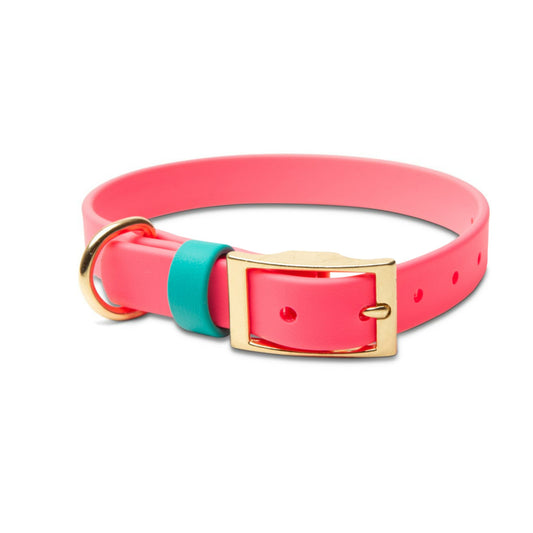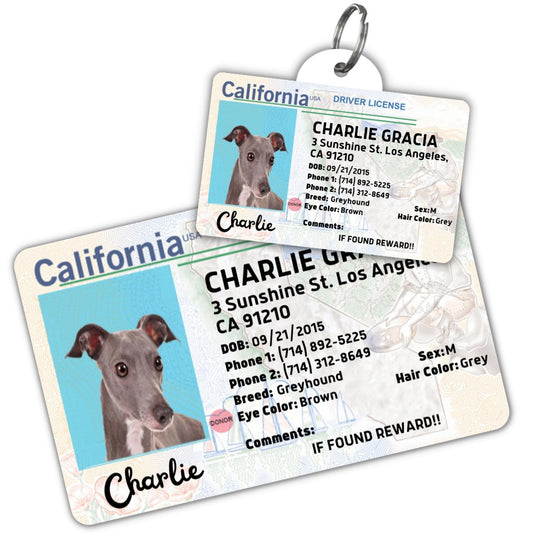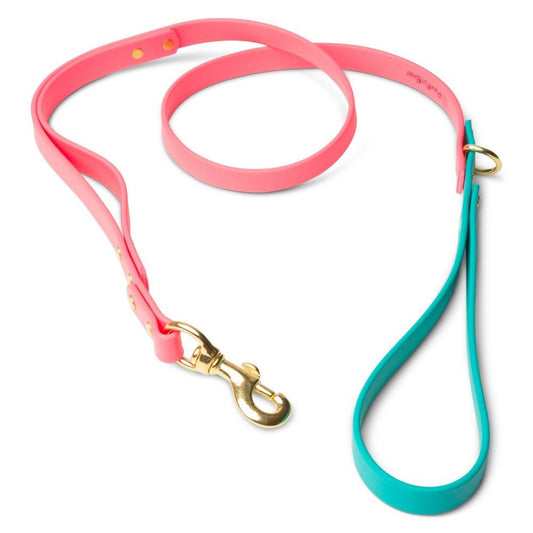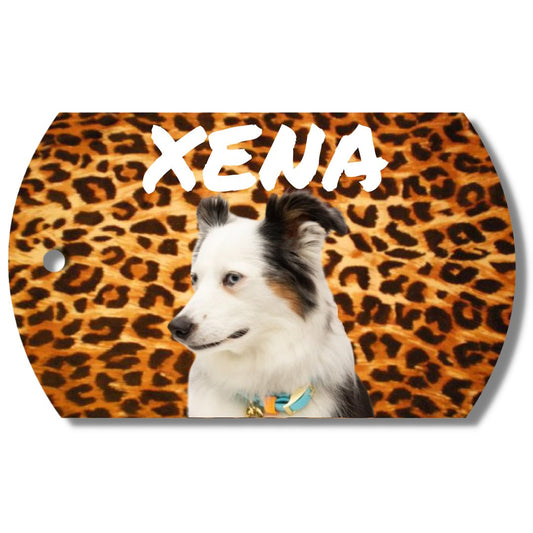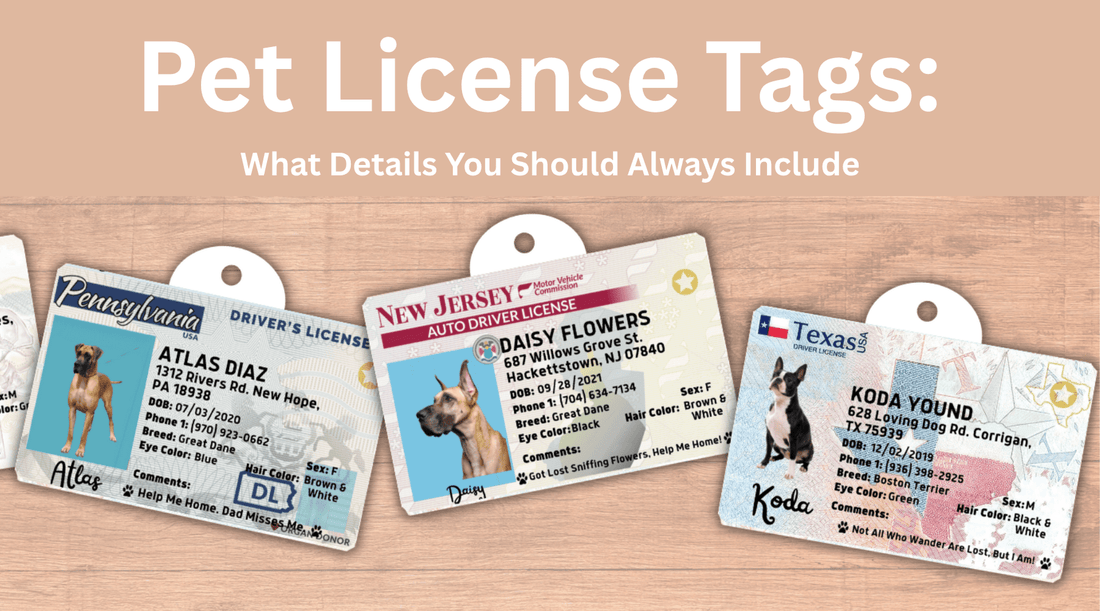
Pet License Tags: What Details You Should Always Include
Your dog's identification tag serves as their voice when they can't speak for themselves. In the terrifying scenario where your pet becomes separated from you, the information on that small piece of metal becomes the critical link between a lost dog and a relieved reunion. While basic ID tags serve their purpose, a drivers license dog tag takes pet identification to an entirely new level—combining comprehensive information with a charming, recognizable format that makes it easy for anyone to help your lost pet.
Understanding what information belongs on your pet's license tag and why each detail matters can mean the difference between a quick reunion and days of desperate searching. Let's explore the essential elements that make dog license tags truly effective while creating an identification system that keeps your furry family member safe.
The Evolution of Pet Identification
Traditional pet ID tags have served dogs for generations, typically featuring just a name and phone number stamped onto a simple metal disc. While functional, these basic tags miss opportunities to provide helpful information that could expedite your pet's safe return. The pet driver's license concept revolutionizes this approach by creating a comprehensive identification document in a familiar, easy-to-understand format.
The genius of the license dog tag format lies in its immediate recognizability. When someone finds your lost dog and sees a miniature driver's license hanging from their collar, they instantly understand they're looking at official identification containing important information. This familiar format encourages people to read the details carefully rather than just glancing at a basic tag.
Essential Information for Your Pet Driver's License
Creating effective id for pets requires strategic thinking about what information proves most valuable in emergency situations. Let's break down each critical element and understand why it matters.
Your Pet's Name
Your dog's name serves multiple purposes beyond simple identification. When a stranger finds your lost pet, knowing their name allows that person to address your dog calmly and build trust. A scared, lost dog responds better to someone calling them by name rather than generic terms like "puppy" or "dog."
The name also helps verify your pet's identity when you're contacted. Scammers sometimes attempt to claim found pets aren't theirs, but knowing specific details like your dog's name provides an additional verification layer. On your drivers license dog tag, the name should be prominently displayed, typically at the top of the tag where it's immediately visible.
Owner Contact Information
Your phone number is arguably the single most important piece of information on any pet ID tag. This direct connection enables immediate contact and the fastest possible reunion. When designing dog license tags, include a primary phone number that you answer reliably throughout the day.
Consider including a secondary contact number as backup. If you're unreachable—perhaps your phone battery died or you're in an area without service—a second number (spouse, family member, or trusted friend) provides an alternative path for someone to reach you.
Your address serves dual purposes. It identifies your pet's home base and provides a physical location where someone might return your dog directly. Some people prefer walking a found dog to the address listed on their tag rather than waiting for phone contact, particularly if they live in a close-knit neighborhood.
Pet Photograph
One distinctive feature of the license dog tag format is the inclusion of your pet's photograph. This might seem purely aesthetic, but it serves important practical functions. The photo provides immediate visual confirmation that the dog wearing the tag is indeed the dog pictured—crucial if someone finds your dog without their collar and wants to verify ownership when seeing found pet notices.
The photograph also creates an emotional connection. When someone sees your dog's adorable face on their license tag, it reinforces that this is a beloved family member, not a stray, encouraging the finder to take extra care in helping return your pet safely.
Breed Information
Including your dog's breed on their pet driver's license provides useful context for anyone who finds them. Certain breeds have specific behavioral traits or needs that a finder should understand. For example, knowing a dog is a husky helps explain why they might have wandered far from home—huskies are notorious escape artists with strong roaming instincts.
Breed information also aids in identification if your dog loses their collar. When you're posting lost pet alerts, being able to reference the breed listed on their license tag adds credibility and detail to your search efforts.
Date of Birth or Age
Your dog's birthdate or current age serves multiple purposes. It helps verify identity during the reunion process and provides important context about your pet's needs. A puppy found without their owner requires different handling than a senior dog. Young puppies might need more frequent bathroom breaks, while elderly dogs might have mobility issues or medical needs.
This information also helps people understand behavioral responses. A young, energetic dog might be overly friendly and bouncy, while an older dog might be more reserved or anxious when approached by strangers.
Physical Characteristics
Details like eye color, coat color, and distinctive markings create a complete identification profile. While these details might seem obvious when looking at your dog, they become crucial for verification purposes, particularly if someone finds your dog far from home and wants to confirm they've located the right pet when seeing your found pet posts online.
These physical descriptors are particularly valuable for breeds where individual dogs can look quite similar to each other. A golden retriever's specific eye color or a beagle's particular marking pattern helps distinguish your specific dog from others of the same breed.
Why Dog License Tags Outperform Basic ID Tags

The comprehensive nature of a license dog tag provides advantages that simple ID tags cannot match. The format encourages thorough information inclusion while maintaining organization and readability.
Immediate Information Hierarchy
The license plate format naturally creates visual hierarchy. Your pet's photo draws attention first, followed by their name in prominent placement, then contact information and supporting details. This intuitive layout ensures people absorb the most critical information first while having access to comprehensive details if needed.
Basic ID tags often cram information together without clear organization, making it harder to quickly identify what's most important. The structured format of dog license tags eliminates this problem entirely.
Verification and Legitimacy
A pet driver's license looks official and legitimate in ways that basic tags don't. This perceived authority encourages people to take the information seriously and act responsibly with a found pet. The professional appearance suggests the owner has invested care and attention in their pet's safety, which often translates to people going the extra mile to ensure your dog's safe return.
Conversation Starter Benefits
The novelty and charm of a drivers license dog tag often sparks conversations with other pet owners during walks or at dog parks. These interactions serve dual purposes—they're enjoyable social moments, and they help your neighbors and community members remember your dog. If your pet ever goes missing, those connections might lead to faster identification and recovery.
State-Specific Designs Add Personal Touch
PawFurEver offers dog license tags designed to match all 50 U.S. states plus Washington D.C., allowing you to showcase state pride while providing comprehensive pet identification. These state-specific designs add personality and regional identity to your pet's ID.
A California-themed tag might feature golden poppies or bear imagery, while a Texas design could incorporate bluebonnets or lone star motifs. New York tags might reflect the state's iconic scenery, and Florida designs could embrace tropical themes. These regional touches make your pet's ID for pets both functional and fun.
The state-specific approach also helps create immediate geographic context. If your dog is found far from home, the state design on their license tag provides helpful information about where they originated, potentially aiding in reunification efforts.
Customization Options for Perfect Personalization
When creating your pet driver's license through PawFurEver, extensive customization ensures the tag perfectly suits your pet and preferences.
Color Choices
Select colors that complement your dog's coat and collar while ensuring maximum visibility. Bright, contrasting colors make the tag easier to spot if your dog is found in challenging conditions—at night, in wooded areas, or from a distance.
Font Selection
While maintaining readability remains paramount, you have options for font styles that match your preferences. Clean, clear fonts ensure information is easy to read while still allowing personal aesthetic choices.
Photo Quality Matters
When selecting a photograph for your license dog tag, choose a clear, well-lit image that accurately represents your dog's appearance. Face-forward shots work best, showing distinctive features and eye color. Avoid photos where your dog is significantly puppies if they've since grown, as current appearance aids identification.
Comment Section Strategy
Use the comment field strategically for information that significantly impacts your dog's safety or how they should be handled. Prioritize medical needs, behavioral notes, or microchip information over decorative messages or quotes.
Beyond the Tag: Comprehensive Pet Safety
While dog license tags provide essential identification, they work best as part of a comprehensive pet safety strategy.
Microchipping as Backup
Your pet driver's license should include a note that your dog is microchipped if applicable. Microchips provide permanent identification that can't be lost if a collar comes off, but they require veterinary clinics or animal shelters with scanners to read. The combination of visible ID for pets and invisible microchip creates redundant safety systems.
Regular Information Updates
Life changes require ID tag updates. Moving, changing phone numbers, or updating emergency contacts means your dog license tags need refreshing. Make a habit of reviewing your pet's identification information quarterly to ensure everything remains current and accurate.
Multiple Tags Consideration
Some pet owners choose to have multiple tags—a basic everyday tag with essential info and a detailed drivers license dog tag for special occasions or travel. This redundancy ensures your dog always has current identification regardless of which collar they're wearing.
Legal Requirements and Licensing
Many jurisdictions require dogs to wear license tags issued by local authorities, separate from personal ID tags. These municipal licenses typically include registration numbers that connect to owner databases maintained by animal control agencies.
Your pet driver's license complements but doesn't replace official municipal licenses. However, the comprehensive information on a license dog tag often proves more immediately useful for community members who find your dog, as they can contact you directly rather than calling animal control during business hours.
Check your local regulations regarding pet identification requirements. Some areas mandate visible ID tags, while others simply require current microchips. Understanding these requirements ensures you remain compliant while maximizing your pet's safety.
The Emotional Value of Comprehensive ID
Beyond practical benefits, creating a detailed pet driver's license demonstrates the depth of your commitment to your dog's wellbeing. The time and thought invested in comprehensive identification reflects how much your pet means to you—they're not just an animal but a valued family member deserving every protection.
This emotional dimension shouldn't be underestimated. When someone finds a dog wearing a thoughtfully designed license tag complete with photo and detailed information, they immediately understand this is someone's cherished companion. That recognition often inspires extra effort and care in facilitating a safe reunion.
Ordering Your Pet Driver's License
PawFurEver makes creating comprehensive id for pets simple and affordable. Their collection includes designs for all 50 states plus Washington D.C., ensuring you can create perfect identification that combines functionality with regional pride.
The high-quality materials ensure your dog license tags remain readable and intact through years of active dog life. Unlike cheap plastic tags that crack or fade, PawFurEver's durable construction means one-time investment provides long-lasting protection.
The ordering process accommodates all necessary customization—photo upload, information entry, color selection, and design choices—ensuring your pet's license tag precisely meets your needs. The result is a professional, comprehensive identification tag that keeps your beloved companion safe while showcasing their personality.
Making Your Pet's Safety a Priority
Every responsible dog owner dreads the possibility of their pet going missing. While we hope it never happens, preparation makes all the difference between a brief scare and a prolonged nightmare. Investing in comprehensive dog license tags provides peace of mind that you've done everything possible to protect your four-legged family member.
The small metal tag hanging from your dog's collar carries enormous responsibility. It might be the only thing standing between your lost pet and home. Making sure that tag contains complete, accurate, easy-to-read information isn't just sensible—it's essential.
A drivers license dog tag from PawFurEver provides the perfect combination of comprehensive information, professional presentation, and charming personality. Your dog deserves identification that matches their importance in your life, and you deserve the peace of mind that comes from knowing you've maximized their chances of a safe return if the unexpected happens.
Conclusion
Creating effective identification for your dog requires balancing comprehensive information with readable, organized presentation. Pet driver's license tags achieve this balance beautifully, providing extensive details in a familiar, professional format that encourages people to help reunite lost pets with their families.
From essential contact information to helpful medical notes, from current photographs to state-specific designs, every element of a well-designed license dog tag serves a purpose in keeping your pet safe. When you invest in quality id for pets through PawFurEver, you're making a statement about your dog's value and your commitment to their wellbeing.
Don't wait for an emergency to realize your dog's identification is inadequate. Take time now to create comprehensive, professional dog license tags that give your beloved companion the protection they deserve. After all, they'd do anything to find their way back to you—the least you can do is make that journey as short and safe as possible.
1. What's the difference between a drivers license dog tag and regular ID tags?
A pet driver's license includes comprehensive information like photos, date of birth, breed, eye color, and medical notes in an organized license format. Regular tags typically only have name and phone number, missing valuable details that help in emergency situations.
2. Do I still need a license dog tag if my dog is microchipped?
Yes, both serve different purposes. Microchips require scanners to read, while visible license tags provide immediate contact information for anyone who finds your dog. Note "MICROCHIPPED" on your tag for redundant protection.
3. How much information should I include on my pet driver's license?
Include essentials: your phone number (primary), dog's name, breed, your address, and critical medical/behavioral notes. Secondary contact numbers and physical characteristics add value. Prioritize information that helps return your pet quickly and safely.
4. Can I customize my dog license tags with state-specific designs?
Yes! PawFurEver offers designs for all 50 states plus Washington D.C., allowing you to showcase regional pride while providing comprehensive identification. State-specific designs add personality while maintaining all essential safety information.
5. How often should I update my pet's id for pets tags?
Review information quarterly and update immediately when changing phone numbers, addresses, or if your dog develops medical conditions. Replace worn or faded tags to ensure information remains clearly visible and readable at all times.


